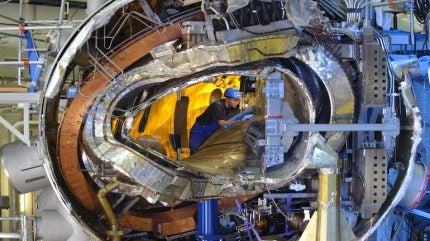
Future nuclear fusion power plants will not be able to complement wind and solar electricity production because they will likely need to run around the clock for economic and technical reasons, concludes a German parliamentary report by the parliament’s office of technology assessment (TAB). But even though the technology will arrive too late to help Europe on its way to climate neutrality by mid-century, it could operate well in industry applications such as hydrogen production, or form part of future electricity systems that are not entirely dominated by renewables, according to some experts.
‘In order to compensate for the fluctuating feed-in of solar and wind power, quickly controllable power plants with low investment costs are required,’ the report says. ‘Fusion power plants will not be able to fulfil this task in the foreseeable future.’
The TAB is an independent scientific institution set up to advise parliament and its committees with impartial analyses on technological developments and their impact on society. Germany’s former research minister Bettina Stark-Watzinger had called nuclear fusion “a huge opportunity to solve all our energy problems” and boosted research with a new funding programme in 2023. But critics warned that enthusiasm for nuclear fusion is a harmful distraction because the technology will be too late and too expensive to contribute to creating a climate-neutral energy system in the coming years and decades.
The report for parliament emphasises that fusion power reactors are still a long way away despite recent advances, even though it is based on the assumption that the first step – a plasma that can generate energy – will function reliably in the near future. But many technical hurdles on the way to a proper fusion power plant remain unsolved, the report stresses.
Nuclear fusion experts not involved with the report agreed that fusion power plants will not become a reality before 2045, the year Germany aims to become climate-neutral, even under ideal circumstances.
“With significantly higher subsidies and approval procedures suitable for fusion, the first power plant could be connected to the grid around 20 years after the start of an ambitious programme,” Sibylle Günter, scientific director of the Max Planck Institute for Plasma Physics, told the Science Media Centre.
But Günter questioned the report’s finding that fusion power plants will not harmonise well with renewables. “Fusion power plants can interact very well and sensibly with renewables in a future electricity market,” Günter said, adding that they “could provide electricity when needed and produce chemical energy storage such as hydrogen at other times”.
“Furthermore, it is not possible today to make a serious forecast of either Germany’s or the world’s energy situation in the second half of the century,” Günter said, suggesting that fusion plants could also supply heat for industry, or be used to produce artificial fuels such as hydrogen, run CO2 capture, and desalination plants.






